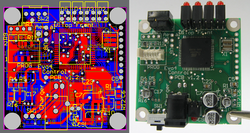When you dealing with computer, you should know the terminologies often used. I’ve compiled some terminologies completed with illustration if possible to make this clearer.
BIOS (basic input/output system) A collection of software codes built into a PC that handle some of the fundamental tasks of sending data from one part of the computer to another.

boot or boot-up The process that takes place when a PC is turned on and performs the routines necessary to get all the components functioning properly and the operating system loaded. The term bootstrap began as a metaphor derived from pull straps sewn onto the backs of leather boots with which a person could pull on their boots without outside help. The term refers to the fact that a computer cannot run without first loading software but must be running before any software can be loaded. Hence, starting a computer is like "lifting yourself with your own bootstraps".
circuit board Originally, wires ran from and to any component in any electrical device, not just computers. A circuit board replaces the need for separate wiring with the metallic traces printed on the board-sometimes also on the bottom of the
board and in a hidden middle layer. The traces lead to connections for processors, resistors, capacitors, and other electrical components. The importance of the circuit board is that its entire creation can be automated, and the board packs more components into an ever-smaller space.
[Figure Above] A PCB as a design on a computer (left) and realized as a board assembly with populated components (right). The board is double sided, with through-hole plating, green solder resist, and white silkscreen printing. Both surface mount and through-hole components have been used.
clock A microchip that regulates the timing and speed of all the computer's functions. The chip includes a crystal that vibrates at a certain frequency when electricity is applied to it. The shortest
length of time in which a computer can perform some operation is one clock, or one vibration of the clock chip. The speed of clocks-and therefore, computers-is expressed in megahertz (MHz). One megahertz is 1 million cycles, or vibrations, a second.
Thus, a PC can be described as having a 200 or 300 MHz processor, which means that the processor has been designed to work with a clock chip running at that speed.

CMOS An acronym for complementary metal oxide semiconductor-a term that describes how a CMOS microchip is manufactured. Powered by a small battery, the CMOS chip retains crucial information about what hardware a PC comprises even when power is turned off.
CPU An acronym for central processing unit, it is used to mean the microprocessor-also, processor-which is a microchip that processes the information and the code (instructions) used by a
computer. The "brains" of a computer. expansion slot Most PCs have unused slots into which the owner can plug circuit boards and hardware to add to the computer's capabilities. Most slots today are personal computer interface
(PCI) or it's next-generation sibling PCI-Express (PCIE). One other slot, the accelerated graphics port (AGP), accepts a video card designed to move images out of memory quickly, although it is fast being replaced by PCI-E-you might also see shorter
slots on older computers. These are industry standard architecture (ISA), the only type of slots on the first Pc.
motherboard A sheet of plastic onto which metallic circuits have been printed and to the rest of the PC's components are connected. These components could be connected via a socket, such as with the CPU, a slot, as with graphics cards and memory modules or they may be built directly onto the motherboard, as with external ports, such as USB.
operating system Software that exists to control the operations of hardware. Essentially, the operating system directs any operation, such as writing data to memory or to disk, and regulates the use of hardware among several application programs that are running at the same time. This frees
program developers from having to write their own
code for these most basic operations.
ROM and RAM Acronyms for Read Only Memory and Random Access Memory. ROM is memory chips or data stored on disks that can be read by the computer's processor. The PC cannot
write new data to those chips or disk drives. RAM is memory or disks that can be both read and written to. Random access memory really is a misnomer because even ROM can be accessed randomly. The term was originally used to distinguish RAM from
data and software that was stored on magnetic tape, and which could be accessed only sequentially. That is, to get to the last chunk of data or code on a tape, a computer must read through all the information contained on the tape until it finds the location where it stored the data or code for which it is looking. In contrast, a computer can jump directly to any information stored in random locations in RAM chips or on disk.
system files Small disk files that contain software code that are the first files a computer reads from disk when it is booted. The system files contain the information needed, following the initial hardware boot, to load the rest of an operating system.
write and read Writing is the process by which a computer stores data in either RAM chips or on a disk drive. Reading is the process by which a computer transfers data or software code from a drive to RAM or from RAM to the microprocessor.

No comments:
Post a Comment